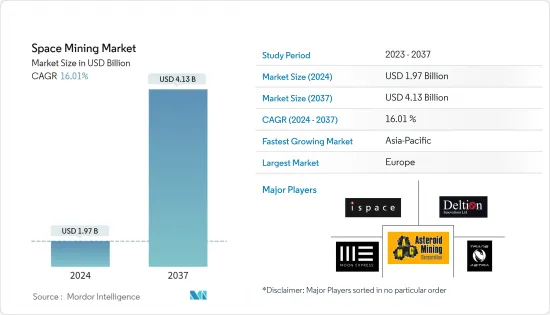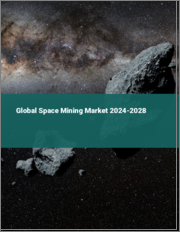
|
시장보고서
상품코드
1438368
세계의 우주 채굴 시장 : 점유율 분석, 산업 동향 및 통계, 성장 예측(2024-2037년)Space Mining - Market Share Analysis, Industry Trends & Statistics, Growth Forecasts (2024 - 2037) |
||||||
우주 채굴(Space Mining) 시장 규모는 2024년 19억 7,000만 달러로 추정되며, 2037년까지 41억 3,000만 달러에 이를 것으로 예측되며, 예측 기간(2024-2037년) 동안 16.01%의 CAGR로 추이하며 성장할 전망입니다.

지난 2년간 COVID-19 팬데믹이 우주 채굴 시장에 미치는 영향은 매우 적었습니다. 제조 부문에서 약간의 지연이 관찰되었지만 우주 채굴 프로그램의 대부분은 궤도로 돌아가 업계는 우주 채굴 활동의 상업화를 향해 천천히 움직이기 시작했습니다.
미국 외에도 룩셈부르크와 아랍에미리트(UAE)은 비즈니스 친화적인 법적 틀에서 투자를 불러들이려고 우주 채굴법을 수립하고 있습니다. 전해지는 바에 따르면, 중국은 우주에서 미국의 경제적 및 안보상의 우위에 과제하는 전략의 일환으로 우주 자원 개발을 국가적 우선 사항으로 간주하고 있지만 러시아, 일본, 인도, 유럽 우주 기관은 독특한 우주 채굴의 야망을 가지고 있습니다.
글로벌 프레임워크의 개발, 민간 부문의 열의의 고조, 실현 가능한 우주 채굴 기술의 출현, 프로젝트 비용의 삭감에 의해 우주 채굴의 대처가 대폭 촉진될 것으로 예상되고 있으며, 조사에는 착륙선이나 탐사차의 대량 생산이 필요합니다.
한편, 우주 채굴 프로그램과 관련된 고가의 비용과 우주 채굴의 기술적 과제는 미래의 투자자를 제한할 수 있어 우주 채굴 시장의 성장에 영향을 미칠 수 있습니다.
우주 채굴 시장 동향
시장 성장을 지원하는 정부의 이니셔티브
현재 정부의 이니셔티브는 시장 성장을 가속하고 있습니다. 정부는 우주에서의 활동을 계획하고 있는 단체에 라이선스를 발행하고 있으며 일부 국가에서는 우주 채굴에 대한 새로운 규제를 시행하고 있습니다. 2015년 미국이 제정한 상업 우주 발사 경쟁력법은 비공개 회사가 지구외에서 채굴 작업을 할 것을 장려하고 있습니다. 2020년 미국 정부는 2015년 법 개정을 받았으며, 이들 기업이 월, 소행성 및 기타 행성에서 사업에서 이익을 얻는 방법에 대해 대통령령을 통해 새로운 규칙을 제정했습니다. 정권은 또한 우주 채굴에 관한 이 미국의 새로운 관점을 기타 국가에 채택하도록 장려할 예정입니다. 또한, 2017년 SpaceResources 이니셔티브의 일환으로 통과된 룩셈부르크 우주 채굴법은 비공개 회사가 지구외에서의 채굴 사업에 대한 제한을 완화하는 것을 목표로 하고 있습니다. 룩셈부르크는 소행성을 포함한 우주에서의 채굴에 관한 법적 규제를 채택한 최초의 국가가 되었습니다. 아랍에미리트(UAE)은 또한 비공개 회사 자원의 완전한 소유권을 유지할 수 있도록 우주 자원 채굴을 규제하는 조치를 취하고 있습니다. 2020년 UAE 우주청은 우주 쓰레기와 운석 처리, 우주 관리 구조 외에 채굴 사업 및 우주 물류 서비스 등 여러 우주 관련 상업 활동의 감독에 종사하는 새로운 UAE 우주법의 상세를 발표했습니다. 위험. 일본은 2021년에 우주탐사개발 관련 상업활동촉진법을 통과하여 달, 소행성, 기타 행성의 상업개발에 기업의 침입을 지지하는 법적 기반을 정비하는 4번째 국가가 되었습니다. 자원. 선수들이 우주 채굴을 쉽게 이용할 수 있도록 하는 이러한 정부의 이니셔티브는 수익성이 높은 산업에 대한 투자를 장려하여 예측 기간 동안 시장 성장을 가속할 것으로 예상됩니다.
아시아 태평양은 예측기간 동안 가장 높은 CAGR이 예상
아시아 태평양의 여러 국가가 우주 채굴 부문에 초점을 맞추기 시작했기 때문에 시장은 예측 기간 동안 아시아 태평양에서 가장 높은 CAGR을 나타낼 것으로 예상됩니다. 중국은 우주 무역을 지배하려는 미국의 노력을 저지하기 위한 기술 경쟁을 추진하고 있습니다. 중국의 민간 및 국유 항공우주 기업은 최근 수많은 활동에 종사했습니다. 2021년 10월 중국항공우주과학기술총공사(CASC)의 일부인 항공우주고체추진기술원(AASPT)은 500톤의 추력을 낳는 고체로켓 모터의 발사시험을 실시했습니다. 이 로켓은 중국의 중량물 운반 로켓의 차기형을 추진하도록 설계되어 있으며, 유인 달 표면 착륙, 심우주 탐사, 지구외 자원 채굴 등 우주 미션에 대한 다양한 수요를 충족시킬 것입니다. 또한 2021년 4월, Shenzhen Origin Space Technology Co. Ltd는 소행성에서 달 표면에 이르기까지 우주 자원 채굴에 특화된 최초의 상업 우주선 'NEO-1'을 출시했습니다. 중국 이외에 인도도 달에서 헬륨 3을 추출할 계획을 부상시키고 있습니다. 이와 관련하여 인도 우주조사기관(ISRO)은 헬륨 3이 풍부하게 함유된 달의 먼지를 채굴하고 에너지를 생산하고 지구로 운송할 계획입니다. ISRO의 월진 채굴 계획은 2022년까지 탄화수소에 대한 수입 의존도를 10% 포인트 줄이는 인도 계획을 배경으로 하고 있습니다. 2021년 6월 일본은 미국, 룩셈부르크, 아랍에미리트(UAE)에 이어 세계에서 4번째 국가가 되었습니다. 에미레이트 항공, 우주 자원 탐사 및 개발을위한 전용법을 초안합니다. 이 법은 일본의 민간사업자가 월이나 기타 천체에서 우주공간에 있는 물, 광물, 기타 비생물자원 등 우주자원의 탐사·개발에 종사하는 것을 인정하고 있습니다. 2020년 12월 일본 Hayabusa-2는 소행성 류구에서 샘플 수집을 마치고 지구로 돌아왔습니다. 이러한 발전은 예측 기간 동안 아시아 태평양에서 조사된 시장에 선호되는 전망을 제공합니다.
우주 채굴 업계 개요
Deltion Innovations Ltd, Moon Express, ispace Inc., Trans Astronautica Corporation, Asteroid Mining Corporation Limited는 시장에서 조사를 계속하는 주요 기업의 일부입니다. 시장은 초기 단계에 있으며 대부분의 발전은 향후 10년 이내에 일어날 것으로 예상됩니다. 전략적인수와 파트너십은 기업의 기술적 능력을 강화하는 데 도움이 될 수 있습니다. 또한 일부 기업은 미래의 우주 채굴을 향해 프로토타입을 테스트하고 있습니다. 예를 들어, 2021년 4월, 중국의 상업 항공우주 회사 Origin Space Co. Ltd는 프로토타입 우주 채굴 우주선 NEO-01을 장정 6호 로켓으로 우주로 보냈습니다. 이 회사는 소행성 채굴과 우주 쓰레기 제거에서 우주선의 능력을 테스트하는 실험을 수행하는 것을 목표로 합니다. 이러한 발전은 예측 기간 동안 시장 전망을 강화할 것으로 예상됩니다.
기타 혜택
- 엑셀 형식 시장 예측(ME) 시트
- 3개월의 애널리스트 서포트
목차
제1장 서론
- 조사의 전제조건
- 조사 범위
제2장 조사 방법
제3장 주요 요약
제4장 시장 역학
- 시장 개요
- 시장 성장 촉진 요인
- 시장 성장 억제 요인
- PESTLE 분석
제5장 시장 세분화
- 지역
- 북미
- 유럽
- 아시아 태평양
- 세계 기타 지역
제6장 경쟁 구도
- 기업 개요
- Deltion Innovations Ltd
- Moon Express
- ispace
- Asteroid Mining Corporation Limited
- Off-World Inc.
- Trans Astronautica Corporation
제7장 시장 기회 및 향후 동향
LYJThe Space Mining Market size is estimated at USD 1.97 billion in 2024, and is expected to reach USD 4.13 billion by 2037, growing at a CAGR of 16.01% during the forecast period (2024-2037).

The COVID-19 pandemic had a negligible impact on the space mining market over the last two years. Although slight delays were observed in the manufacturing sector, most of the space mining programs are back on track with the industry slowly moving toward the commercialization of space mining activities.
Besides the United States, Luxembourg and the United Arab Emirates are racing to develop space mining laws, hoping to attract investment with business-friendly legal frameworks. While China reportedly views space-resource development as a national priority, as part of a strategy to challenge the US economic and security primacy in space, Russia, Japan, India, and the European Space Agency harbor space-mining ambitions of their own.
The development of a global framework, the growing enthusiasm from the private sector, the advent of a feasible space mining technology, and reduction in project costs are expected to radically boost the space mining efforts, which would require mass production of landers and rovers to survey a mining site prior to setting up a mining rig on any celestial body.
On the other hand, the high costs associated with the space mining programs and the technical and technological challenges in space mining may restrict the prospective investors, thereby affecting the growth of the space mining market.
Space Mining Market Trends
Government Initiatives to Help the Growth of the Market
Government initiatives are currently helping the growth of the market. Governments are issuing licenses to parties planning to conduct activities in space, and some countries are enforcing new regulations for space mining. The Commercial Space Launch Competitiveness Act, enacted by the United States in 2015, encourages private companies to undertake mining work beyond Earth. In 2020, the US administration created new rules through an executive order following the 2015 law change for how those companies may profit from operations on the Moon, asteroids, and other planets. The administration also plans to encourage other nations to adopt this new US perspective on space mining. Moreover, the Luxembourg space mining law, passed as a part of the SpaceResources initiative in 2017, aims to relax restrictions on private companies' mining operations beyond Earth. Luxembourg became the first country to adopt legal regulations pertaining to mining in space, including from asteroids. The United Arab Emirates is also taking steps to regulate mining for resources in space so private companies can retain full ownership of the mined resources. In 2020, the UAE Space Agency announced the details of the new UAE Space Law that tackles oversee several space-related commercial activities, including mining operations and space logistics services, in addition to the mechanism for dealing with space debris, meteorites, and managing space risks. Japan became the fourth nation in 2021 to lay the legal foundations that favor the incursion of its companies into the commercial exploitation of the Moon, asteroids, and other planets after passing the Law for the Promotion of Commercial Activities Related to the Exploration and Exploitation of Space Resources. Such government initiatives aimed at facilitating the players to take advantage of space mining are expected to encourage them to invest in the highly profitable industry, thereby driving the growth of the market during the forecast period.
Asia-Pacific Expected to Witness the Highest CAGR During the Forecast Period
The market is expected to witness the highest CAGR in Asia-Pacific during the forecast period, as several countries in the region started to shift their focus toward the space mining sector. China is engaged in a technological race to thwart the increasing efforts of the United States to dominate space commerce. China's private and state-owned aerospace companies were engaged in a slew of activities recently. In October 2021, the Academy of Aerospace Solid Propulsion Technology (AASPT), a part of the China Aerospace Science and Technology Corporation (CASC), test-fired a solid rocket motor producing 500 tons of thrust. The rocket is designed to propel the next iteration of China's heavy-lift rockets, which would meet various demands for space missions like crewed Moon landings, deep space exploration, and off-world resource extraction. Also, in April 2021, Shenzhen Origin Space Technology Co. Ltd launched the first commercial spacecraft named NEO-1, dedicated to mining space resources, ranging from asteroids to the lunar surface. In addition to China, India has also floated plans about extracting Helium-3 from the Moon. On this note, the Indian Space Research Organization (ISRO) plans to mine Helium-3 rich lunar dust, generate energy, and transport it back to Earth. ISRO's lunar dust mining plan comes in the backdrop of India's plan to cut down import dependence on hydrocarbons by 10 percentage points by 2022. In June 2021, Japan became the fourth country in the world, after the United States, Luxembourg, and the United Arab Emirates, to draft a dedicated law for the exploration and exploitation of space resources. The law permits Japanese private business operators to engage in the exploration and development of space resources, such as water, minerals, and other non-living resources in outer space, on the Moon and other celestial bodies. In December 2020, Japan's Hayabusa-2 returned to Earth post collecting samples from the Ryugu asteroid. Such developments render a favorable outlook for the market studied in Asia-Pacific during the forecast period.
Space Mining Industry Overview
Deltion Innovations Ltd, Moon Express, ispace Inc., Trans Astronautica Corporation, and Asteroid Mining Corporation Limited are some of the prominent players continuing their research in the market. The market is in its nascent stage, with most of the progress expected to come in the next decade. Strategic acquisitions and partnerships may help the players to enhance their technological capabilities. Also, several companies are testing their prototypes for future space mining. For instance, in April 2021, the Chinese commercial aerospace company Origin Space Co. Ltd sent its prototype space mining spacecraft NEO-01 into space by a Long March-6 rocket. The company aims to carry out experiments to test the spacecraft's capabilities in asteroid mining and space debris removal. Such developments are expected to bolster the market prospects during the forecast period.
Additional Benefits:
- The market estimate (ME) sheet in Excel format
- 3 months of analyst support
TABLE OF CONTENTS
1 INTRODUCTION
- 1.1 Study Assumptions
- 1.2 Scope of the Study
2 RESEARCH METHODOLOGY
3 EXECUTIVE SUMMARY
4 MARKET DYNAMICS
- 4.1 Market Overview
- 4.2 Market Drivers
- 4.3 Market Restraints
- 4.4 PESTLE Analysis
5 MARKET SEGMENTATION (Market Size by Value - USD billion)
- 5.1 Geography
- 5.1.1 North America
- 5.1.2 Europe
- 5.1.3 Asia-Pacific
- 5.1.4 Rest of World
6 COMPETITIVE LANDSCAPE
- 6.1 Company Profiles
- 6.1.1 Deltion Innovations Ltd
- 6.1.2 Moon Express
- 6.1.3 ispace
- 6.1.4 Asteroid Mining Corporation Limited
- 6.1.5 Off-World Inc.
- 6.1.6 Trans Astronautica Corporation













